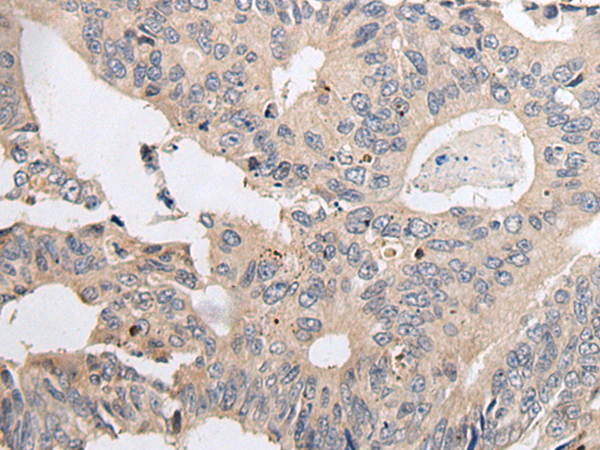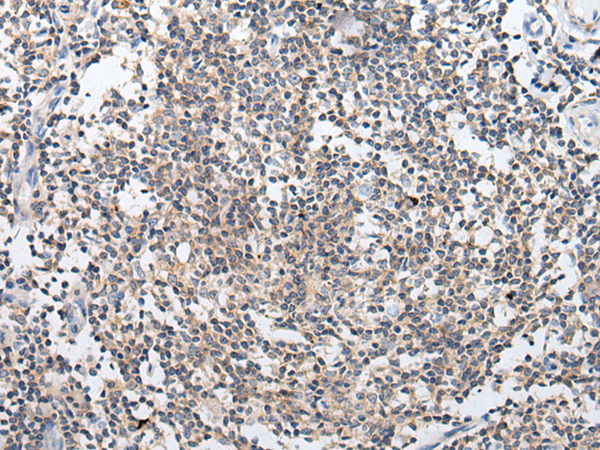

| WB | 咨询技术 | Human,Mouse,Rat |
| IF | 咨询技术 | Human,Mouse,Rat |
| IHC | 1/25-1/100 | Human,Mouse,Rat |
| ICC | 技术咨询 | Human,Mouse,Rat |
| FCM | 咨询技术 | Human,Mouse,Rat |
| Elisa | 1/5000-1/10000 | Human,Mouse,Rat |
| Aliases | ARL5; ARFLP5 |
| Host/Isotype | Rabbit IgG |
| Antibody Type | Primary antibody |
| Storage | Store at 4°C short term. Aliquot and store at -20°C long term. Avoid freeze/thaw cycles. |
| Species Reactivity | Human, Mouse, Rat |
| Immunogen | Synthetic peptide of human ARL5A |
| Formulation | Purified antibody in PBS with 0.05% sodium azide and 50% glycerol. |
+ +
以下是关于ARL5A抗体的3篇示例文献(注:部分内容为示例性概括,实际文献需根据具体研究补充):
1. **文献名称**:*ARL5A regulates vesicular trafficking and cell migration in colorectal cancer*
**作者**:Chen et al.
**摘要**:本研究利用ARL5A特异性抗体进行免疫印迹和免疫荧光实验,发现ARL5A通过调控高尔基体相关囊泡运输促进结直肠癌细胞迁移,并揭示其表达水平与患者预后相关。
2. **文献名称**:*Characterization of a novel monoclonal antibody against human ARL5A for subcellular localization studies*
**作者**:Tanaka et al.
**摘要**:文章报道了一种新型ARL5A单克隆抗体的开发与验证,通过免疫沉淀和共聚焦显微镜技术证实ARL5A定位于线粒体外膜,并参与细胞能量代谢调控。
3. **文献名称**:*ARL5A interacts with autophagy-related proteins and modulates lysosomal function*
**作者**:Wang & Liu
**摘要**:通过ARL5A抗体进行免疫共沉淀和蛋白质组学分析,发现ARL5A与自噬相关蛋白(如LC3)相互作用,影响溶酶体功能,可能在神经退行性疾病中发挥作用。
如需具体文献,建议在PubMed或Google Scholar以“ARL5A antibody”或“ARL5A function”为关键词检索最新研究。
The ADP-ribosylation factor-like 5A (ARL5A) protein is a member of the ARF/ARL family of small GTP-binding proteins, which regulate intracellular trafficking, membrane remodeling, and signaling. ARL5A, also known as ARL11. is evolutionarily conserved and shares structural homology with other ARL family members but exhibits distinct functional characteristics. It localizes to the Golgi apparatus and endosomal compartments, suggesting roles in vesicular transport or organelle dynamics. Studies link ARL5A to lipid metabolism, cell cycle regulation, and tumor suppression, though its precise molecular mechanisms remain under investigation.
ARL5A antibodies are essential tools for studying its expression, localization, and interactions. These antibodies are typically raised in rabbits or mice using synthetic peptides or recombinant protein fragments corresponding to conserved regions of ARL5A. Validation methods include Western blotting to confirm specificity (e.g., detecting a ~22 kDa band), immunofluorescence for subcellular localization, and knockdown/knockout controls to rule off-target signals. Commercial and custom ARL5A antibodies have been employed in cancer research, particularly exploring its potential tumor-suppressive role in colorectal and gastric cancers. However, ARL5A's tissue distribution, post-translational modifications, and disease-associated pathways remain poorly characterized, necessitating further research. Reliable antibodies are critical for elucidating ARL5A's biological functions and therapeutic relevance.
×